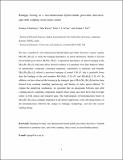Files in this item
Bandgap bowing in a zero-dimensional hybrid halide perovskite derivative : spin-orbit coupling: versus lattice strain
Item metadata
| dc.contributor.author | Chatterjee, Soumyo | |
| dc.contributor.author | Payne, Julia | |
| dc.contributor.author | Irvine, John T.S. | |
| dc.contributor.author | Pal, Amlan J. | |
| dc.date.accessioned | 2021-02-03T00:37:04Z | |
| dc.date.available | 2021-02-03T00:37:04Z | |
| dc.date.issued | 2020-02-28 | |
| dc.identifier | 266954523 | |
| dc.identifier | 9cb6b5a7-9bbd-4fd4-9ff5-4a341b441572 | |
| dc.identifier | 85080958291 | |
| dc.identifier | 000519704200022 | |
| dc.identifier.citation | Chatterjee , S , Payne , J , Irvine , J T S & Pal , A J 2020 , ' Bandgap bowing in a zero-dimensional hybrid halide perovskite derivative : spin-orbit coupling: versus lattice strain ' , Journal of Materials Chemistry A , vol. 8 , no. 8 , pp. 4416-4427 . https://doi.org/10.1039/c9ta12263j | en |
| dc.identifier.issn | 2050-7488 | |
| dc.identifier.other | ORCID: /0000-0002-8394-3359/work/70919727 | |
| dc.identifier.other | ORCID: /0000-0003-3324-6018/work/70919993 | |
| dc.identifier.uri | https://hdl.handle.net/10023/21360 | |
| dc.description | A.J.P. acknowledges the JC Bose National Fellowship of SERB (SB/S2/JCB-001/2016) and S.C. acknowledges the DST INSPIRE Fellowship (IF 140158) and Newton-Bhabha PhD placements programme 2017–18 (DST/INSPIRE/NBHF/2017/25). | en |
| dc.description.abstract | We have considered a zero-dimensional hybrid halide perovskite derivative system, namely MA3(Sb1-xBix)2I9, to study the bandgap dependence on metal substitution. Similar to tin-lead mixed halide perovskites (MASn1-xPbxI3), the composition dependence of the optical bandgap in the MA3(Sb1-xBix)2I9 solid-state alloys showed evidence of a quadratic (bow-like) behavior where an intermediate compound containing an equimolar contribution of antimony and bismuth, MA3(Sb0.5Bi0.5)2I9 offered the narrowest bandgap of around 1.90 eV; this is markedly lower than the bandgap of the end members MA3Sb2I9 (2.36 eV) and MA3Bi2I9 (2.16 eV). In addition, we have observed the bowing in the transport gap of MA3(Sb1-xBix)2I9 that has been derived from scanning tunneling spectroscopy and density of states spectra thereof. To explain the underlying mechanism, we speculate that an antagonism between spin orbit coupling and its competing component, namely lattice strain, may have led to this bow-like nature in both optical and transport gaps. The band-diagram of heterojunctions based on MA3(Sb1-xBix)2I9 accordingly depended on the metal-composition; solar cell characteristics of the heterojunctions followed the change in the bandgap, morphology, and also the exciton binding energy. | |
| dc.format.extent | 12 | |
| dc.format.extent | 1258179 | |
| dc.language.iso | eng | |
| dc.relation.ispartof | Journal of Materials Chemistry A | en |
| dc.subject | Bandgap bowing | en |
| dc.subject | Zero-dimensional hybrid halide perovskite derivative | en |
| dc.subject | Bismuth substitution at antimony sites | en |
| dc.subject | Spin-orbit coupling | en |
| dc.subject | Lattice strain | en |
| dc.subject | Exciton binding energy | en |
| dc.subject | QD Chemistry | en |
| dc.subject | Chemistry(all) | en |
| dc.subject | Renewable Energy, Sustainability and the Environment | en |
| dc.subject | Materials Science(all) | en |
| dc.subject | DAS | en |
| dc.subject | SDG 7 - Affordable and Clean Energy | en |
| dc.subject.lcc | QD | en |
| dc.title | Bandgap bowing in a zero-dimensional hybrid halide perovskite derivative : spin-orbit coupling: versus lattice strain | en |
| dc.type | Journal article | en |
| dc.contributor.institution | University of St Andrews. School of Chemistry | en |
| dc.contributor.institution | University of St Andrews. Centre for Designer Quantum Materials | en |
| dc.contributor.institution | University of St Andrews. EaSTCHEM | en |
| dc.identifier.doi | 10.1039/c9ta12263j | |
| dc.description.status | Peer reviewed | en |
| dc.date.embargoedUntil | 2021-02-03 |
This item appears in the following Collection(s)
Items in the St Andrews Research Repository are protected by copyright, with all rights reserved, unless otherwise indicated.

